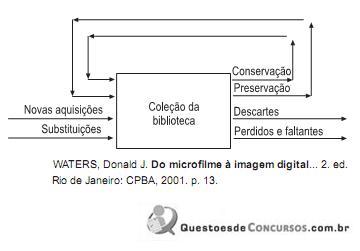Questões de Concurso
Comentadas para finep
Foram encontradas 406 questões
Resolva questões gratuitamente!
Junte-se a mais de 4 milhões de concurseiros!
Segundo o AACR2, tais datas serão expressas da seguinte forma:
Em qual das opções abaixo a referência para esse tipo de documento está de acordo com o padrão formalizado pela NBR 6023, da ABNT?

A coleção em suporte papel de uma biblioteca está sujeita a processos distintos e constantes de depreciação e renovação. Na figura acima, a conservação e a preservação são representadas como processos ininterruptos e interdependentes que favorecem a manutenção da coleção ou a reincorporação de um item, por exemplo, após necessária restauração do suporte.
Considerando os custos inerentes, a reincorporação de um item restaurado à coleção pressupõe novas
PORQUE
Um sistema especialista para o serviço de referência de uma unidade de informação incorpora a capacidade de encontrar as respostas nas situações em que soluções algorítmicas não sejam aplicáveis.
Analisando-se as afirmações acima, conclui-se que
I - 622+614
622:533.9
622(091)
622.3
623
II - 622/625
622(81)
622.23
622.3
622.3:378
III - 622(091)
623
622:533.9
622.3/.4
623/625
IV - 622.15(94)
623.5
622(81)
622.3
622/625
Estão corretas, de acordo com a CDU, as ordens de arquivamento apresentadas em
Nesse contexto, formatos-padrões serão necessários para
I - Auxilares Especiais
II - Asteriscos
III - Auxiliares Comuns Independentes
IV - Dois Pontos Duplos
P - São categorias de conceitos que tomam sentido diferente em cada classe.
Q - Têm como finalidade estabelecer a síntese integradora.
R - Podem ser justapostos a qualquer número e também usados isoladamente.
S - Especificam o assunto por meio de notações que não pertencem à CDU.
T - Têm a função de ordenação na construção de notações.
As associações corretas são
PORQUE
Na combinação dos termos, nos sistemas de indexação pós-coordenados, preserva-se a multidimensionalidade das relações entre os termos, sendo a todo termo atribuído peso igual.
Analisando-se as afirmações acima, conclui-se que
I - Analítica P - Difere da normativa por ser mais flexível.
II - Normativa Q - Está protegida pela lei de direitos autorais.
III - Interpretativa R - Tem caráter geral, pois se aplica a todos indiscriminadamente.
S - Caracteriza-se pela emissão de uma opinião particular.
As associações corretas são:
PORQUE
A informação gerencial é aquela gerada, controlada ou disseminada numa organização para aperfeiçoar o atendimento de seus objetivos de negócios.
Analisando as afirmações acima, conclui-se que
By Kim Painter, USA TODAY, April 7th, 2011
Remember the lunch hour? In a more relaxed, less plugged-in era, office workers would rise up midday to eat food at tables, gossip with co-workers, enjoy a book on a park bench or take a walk in the sun. Can it still be done, without invoking the scorn of desk-bound colleagues or enduring constant electronic interruptions? It can and should. Here are five ways to break free: 1. Give yourself permission. As the hair-color ads say, “You're worth it." Taking a break in the workday is more than an indulgence, though: It's a way of taking care of your body and mind, says Laura Stack, a time-management expert and author who blogs at theproductivitypro.com. “You have to eliminate the guilt and remind yourself that the more you take care of yourself, the better you are able to take care of others," she says. “We have to recharge our batteries. We have to refresh. It's OK." 2. Get a posse. “Indeed, many people are wishing they could just peel themselves away, but they don't have the discipline," Stack says. Thus, invite a co-worker to take daily walks with you or a group to gather for Friday lunches. Pretty soon, you'll be working in a happier place (and feeling less like a shirker and more like a leader). 3. Schedule it. Put it on your calendar and on any electronic schedule visible to co-workers. “Code yourself as 'unavailable.' Nobody has to know why," says Laura Vanderkam, author of 168 Hours: You Have More Time Than You Think. And, if a daily hour of “me time" seems impossible right now, then commit to just one or two big breaks a week. Or schedule several 15-minute leg-stretching, mind-freeing breaks each day. Keep those appointments, and spend them in “a cone of silence," without electronic devices, Vanderkam says. 4. Apply deadline pressure. The promise of a lunch break could make for a more productive morning: “Treat it as a deadline or a game," Stack says. Pick a meaty task or two that must be finished before lunch and dive in. Plan what you'll finish in the afternoon, too. That will free your mind to enjoy the break, Vanderkam says. 5. Eat at your desk. That's right: If you can't beat them, seem to join them. If you really don't care about eating elsewhere, “pack your lunch and eat it at your desk, and save the time for something you'd rather do," whether it's going to the gym or sneaking out to your car to read, Vanderkam says. (But remember, you still have to schedule this break.) While most co-workers care less about your habits than you think they do, she says, “this has the extra advantage that you can be seen eating at your desk." . Access on April 7th, 2011. Adapted.
I - O usuário poderá fornecer um roteiro com múltiplos pontos de parada.
II - O total a ser pago deverá ser expresso na moeda escolhida pelo usuário.
III - As trocas de informações com os sistemas das empresas coligadas (hotéis, locadora de veículos, etc.) são feitas através de Web Services.
É(São) requisito(s) funcional(ais) o que é apresentado em